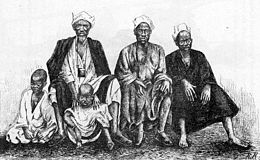
Back Bambara (volk) Afrikaans بمبارة Arabic بامبارا ARZ Bambaralar Azerbaijani Бамбара Bulgarian Bamanan BM Bambared Breton Bambares Catalan گەلی بامبارا CKB Bambarové Czech
This article includes a list of general references, but it lacks sufficient corresponding inline citations. (November 2015) |
This article lacks ISBNs for the books listed. (December 2024) |
ߓߡߊߣߊ߲ | |
|---|---|
 Bambara people in upper Sénégal river valley, 1890. (illustration from Colonel Frey's Côte occidentale d'Afrique, 1890, Fig.49 p.87) | |
| Total population | |
| 5,000,000[1] (2019) | |
| Regions with significant populations | |
| Mali, Guinea, Senegal, Burkina Faso, Niger, Ivory Coast, Mauritania, Gambia, Morocco | |
| 6,705,796 (33.3%) [2] | |
| 91,071 (1.34%) (1988 census) [3] | |
| 22,583 (1.3%) [4] | |
| 400 [5] | |
| Languages | |
| Bambara language, French, Arabic (historically) | |
| Religion | |
| Sunni Islam | |
| Related ethnic groups | |
| Mandinka people, Soninke people, other Mande speaking groups. | |
The Bambara (Bambara: ߓߡߊߣߊ߲, romanized: Bamana or ߓߊ߲ߡߊߣߊ߲ Banmana) are a Mandé ethnic group native to much of West Africa, primarily southern Mali, Ghana, Guinea, Burkina Faso and Senegal.[6][7] They have been associated with the historic Bambara Empire. Today, they make up the largest Mandé ethnic group in Mali, with 80% of the population speaking the Bambara language, regardless of ethnicity.
- ^ Bambara at Ethnologue (18th ed., 2019)
- ^ "Mali". www.cia.gov/. Retrieved November 19, 2020.
- ^ Chiffres de la Division de la Statistique de Dakar cités dans Peuples du Sénégal, Éditions Sépia, 1996, p. 182
- ^ "Distribution of the Gambian population by ethnicity 1973,1983,1993,2003 and 2013 Censuses - GBoS". www.gbosdata.org. Archived from the original on 2021-11-19. Retrieved 2021-06-17.
- ^ "Khamlia, village africain peuplé de Bambara (Gnawa) à 7 km de Merzouga". 22 May 2013.
- ^ "Tribal African Art Bambara (Bamana, Banmana)". Zyama.com - African Art Museum. Retrieved 2008-07-08.
- ^ den Otter, Elisabeth; Esther A. Dagan (1997). Puppets and masks of the Bamana and the Bozo (Mali) - from The Spirit's Dance in Africa. Galerie Amrad African Arts Publications.